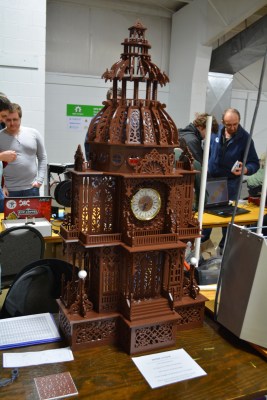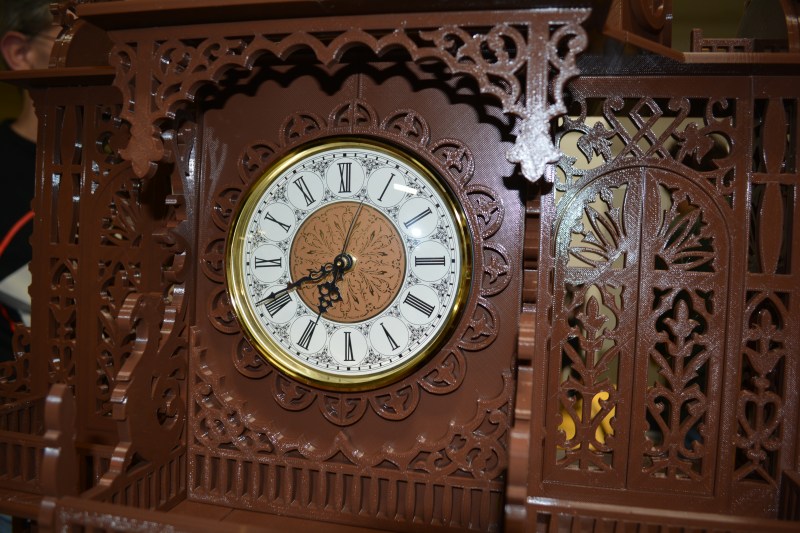[Jason] is a woodworker. At least, he was until he saw his first 3D printer. While he may still work in wood, he particularly likes adapting scroll saw patterns for 3D printing. His clock started as a woodworking pattern for use on a scroll saw. To adapt it for 3D printing, [Jason] scanned the plotter-sized pattern pieces into Inkscape, where he was able to do things like add bevels before sending the pieces to OpenSCAD.
 As you might imagine, a great deal of work went into this build, beginning with the scanning. [Jason] starting scanning last October and finished in January. Printing started January 9th, and he told me the final pieces were printed early this morning. We know you want all the details, so here goes: this build took just over six rolls of PLA at 20% infill. It’s 48″ tall and about 24″ wide. It was printed on what [Jason] referred to as his “very modified” Replicator 2. He glued the pieces together with Testor’s, and that took about 30 hours. All through the project, he kept meticulous notes in a spreadsheet of print times and filament used.
As you might imagine, a great deal of work went into this build, beginning with the scanning. [Jason] starting scanning last October and finished in January. Printing started January 9th, and he told me the final pieces were printed early this morning. We know you want all the details, so here goes: this build took just over six rolls of PLA at 20% infill. It’s 48″ tall and about 24″ wide. It was printed on what [Jason] referred to as his “very modified” Replicator 2. He glued the pieces together with Testor’s, and that took about 30 hours. All through the project, he kept meticulous notes in a spreadsheet of print times and filament used.
We were honored to be among the first to see [Jason]’s incredible clock build at this year’s Midwest RepRap Festival. He would like to take it on tour this year to the nearby Maker Faires. If he can figure out how transport it safely, he’d like to show it at World Maker Faire in NYC.

















I thought Jason 3d printed molds and made the damn thing out of chocolate. Bit disappointed now, thanks to HAD…. but still a beast of a print nonetheless!
No kidding, this is the definition of clickbait.
You won’t believe the headline Hackaday put on this article!
Agreed – I get enough of this crap on every other website. I would have gladly clicked through if the title was actually descriptive. Instead, I clicked through with the happy side effect of losing respect for HaD. A simple parenthetical (“Chocolate (colored PLA) Clock”) would have avoided that. I hope you’ll reconsider whether it’s worth alienating your audience for a few cheap click-throughs.
+1
+1 too.
Fair enough… I’ve added “(not quite)” to the title.
That was my reaction too. I didn’t realize it when seeing the pictures so I was thinking holy crap that’s a lot of chocolate. It must be 7-8ft tall! Very disappointing. Cool clock none-the-less.
HAD in Chocolate Clock row.. shock horror… reminded me of this.. http://www.bbc.co.uk/news/uk-england-york-north-yorkshire-29126161
Tempest in a clockwork?
Just another cog in the machine.
Wouldn’t last five minutes in my house.
Unless your family is into eating plastic, I think it would last a bit longer :P
Blame the clickbait.
I saw this thing today! It is amazing! First thought that popped into my head was 3D printed doll houses! In person, this thing looks amazing. He did an excellent job on it.
This is even better in person. This guy spent a LOT of time and effort into making it. Just proves the fact that you are only limited by your imagination.
Did you read that on a Hallmark card? Either you have a VERY limited imagination, or your statement is full of fluff.
mmm… fluff… goes well with chocolate
+1 also I want chocolate fluff filled donut
I want one! :)
*gnaws on clock* What the? PLAstic? HaD, you lied to me!
On Antiques Roadshow 2115. “This is a primitive 3D printed folk art clock, made by Jason Preuss in Portage, Michigan in the early 21st century. Since his chosen medium was poly-lactic acid, many of his clocks and other works have sadly decomposed. On the up-side, that makes his surviving pieces that have been properly preserved worth more.”
Plastic is fairly hard to break down. If it were easy, we wouldn’t have landfills full of it. PLA might become brittle in the presence of water, but we are talking about maximum saturation–submersion. Even at that, it would take several years before it’s showing signs of deterioration. I printed a tray to hold my laundry detergent in my washer, as LG thought it wasn’t necessary. The detergent runs out of the back onto my clothes before the water can hit and dilute it out. It was leaving blue stains. So printing a small tray that slipped into the detergent slot keeps the detergent in, and water sprays down into the tray and it overflows down on my clothes. It’s been like that for years. The tray typically holds a little leftover water for a week. I’ve routinely inspected the part and so far it looks like the day I printed, other than some staining.
As long as this clock stays dry, it will last for decades. Humidity over time will be the limiting factor on how long this piece lives. But who knows, could take a hundred years in a swamp before it gets brittle.
Galane, It’s comments like this that keep me coming back to other wise lame posts, thanks for the laugh!
Dead link at a woodworking pattern for use on a scroll saw :(
Looks like that whole site is down right now :(